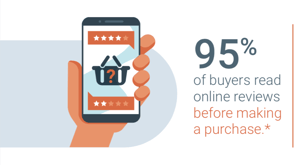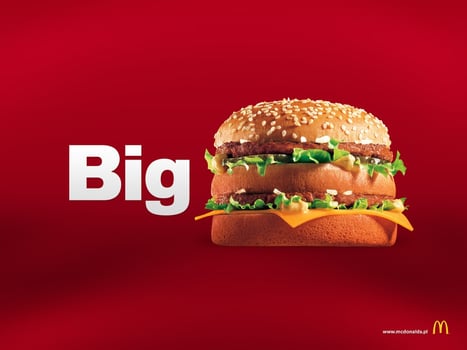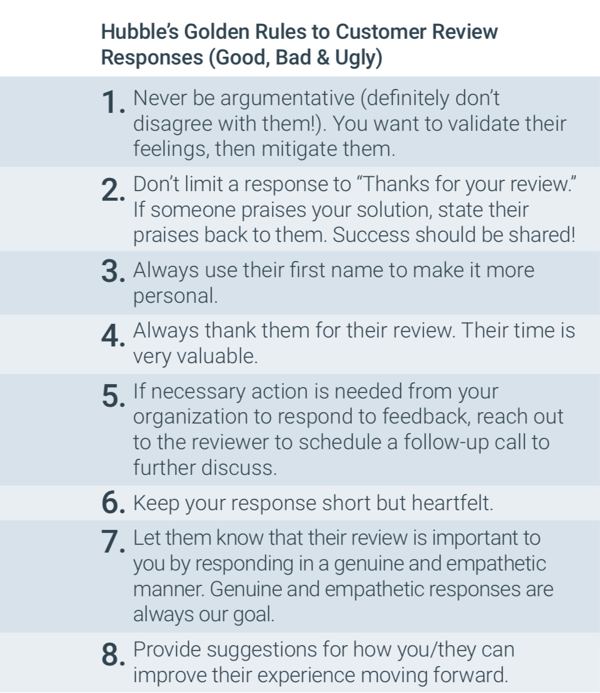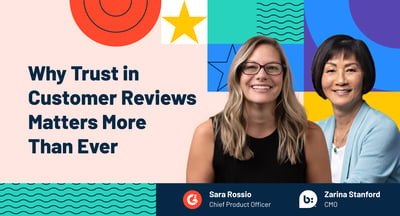
Can you remember the last time you ate at a restaurant without seeking out reviews or asking for a friend’s recommendation?
I can’t.
In fact, I can’t remember the last time I stayed at a hotel, purchased a meal, or bought a $15 kitchen gadget without reading at least a dozen reviews beforehand. If I’m going to hand over my credit card, you can bet that I’ve done my research and become well informed on both the good and the not-so-good.
 Apparently, I’m not alone. Nearly 95 percent of buyers are reading online reviews before making a purchase – and with good reason. As they’ve gained popularity over the last decade, customer reviews have revolutionized the purchasing process.
Apparently, I’m not alone. Nearly 95 percent of buyers are reading online reviews before making a purchase – and with good reason. As they’ve gained popularity over the last decade, customer reviews have revolutionized the purchasing process.
With the rise of social media marketing and online marketplaces, consumers have become more informed and empowered than ever before. There is a plethora of information available with the click of the button. A quick Google search and the answer you need is likely in the top five results. All of this begs the question: Why would we ever spend our money on something about which we're not entirely sure?
The answer is simple. We shouldn’t.
In this guide to customer reviews, we’ll cover everything you need to know about the ever-evolving review economy, whether you’re a reviewer or an employee of the company being reviewed.
We’ll include the customer voice and the changing buying process, the motivation behind writing reviews, how to write a good review, and much more.

Over the last decade, customer reviews have transformed the purchasing process. Due to what is known as the “review economy,” potential buyers are more informed than ever before. They’re empowered with all sorts of information, details, and real experiences.
This information is creating more-informed and more-empowered buyers, ultimately improving the experience for both parties. Pre-purchase, consumers have a realistic expectation for their product or service. Knowing what to expect and then receiving that makes for a happy customer and a happy vendor.
So just how did this new economy come to be?
Humans have almost always sought out opinions on purchases they made. It used to require picking up the phone and calling a friend. However, with the emergence and extreme popularity of social media, consumers were able to quickly reach out to their entire network and almost immediately receive plenty of recommendations regarding where to eat, where to vacation, what to purchase, or even which plumber to use.
Initially, customer reviews were as simple as asking opinions from a group. And even as review websites have emerged, this is still a typical (and helpful) method. Sometimes, it’s nice to hear what people you know have to say about something you haven’t experienced yet. If it’s someone whose tastes you’re familiar with, you’ll have an even better idea of how you’ll feel about their recommendations. For example, consider this quick interaction screen-captured from G2 Crowd’s very own #random Slack channel.

Asking for feedback became more and more popular. This consumer desire for real, candid experiences created an exciting opportunity in the market for third-party platforms where anybody could go and write a review.
Today, you can find customer reviews nearly everywhere, on everything. Third-party review websites covering various topics are plentiful, be it Angie’s List, HomeAdvisor, Yelp, or many, many more. Even the majority of online stores are now featuring customer reviews of any given product.
As consumers, we interact with this new economy nearly every day. Sometimes, it’s for a relatively low-consequence purchase or experience. For example, before grabbing a bite to eat, you’re likely perusing Yelp to see if that new restaurant is all it’s chalked up to be. Or before you purchase your umpteenth phone charger (maybe that’s just me?), you might compare the Amazon.com reviews of your three final contenders.
While it’s certainly nice to have user reviews to refer to in these situations, if the experience goes south, it’s probably not going to disrupt your life too badly (unless you spent all week thinking about Friday night’s cheat meal).
On the other hand, reviews also play a significant role when we’re spending a lot of money or making high-impact decisions. For example, if you’re about to spend $10,000 booking a 20-day European vacation, you’ll probably want to go through reviews on TripAdvisor pretty comprehensively.
We’ve all heard the horrors of a hotel reservation gone wrong: bed bugs, haunted rooms, noisy neighbors, or much, much worse. Hotel reviews enable travelers to avoid being victim to nightmare-inducing experiences before they’re forced to make what can be a major financial commitment.
And speaking of significant purchases, companies spend tens of thousands of dollars (if not much more) on the software as a service (SaaS) they purchase. Before this review economy, we likely based these purchases off a sales pitch (which are inherently biased) or an analyst report (often outdated). Today, customer reviews allow companies to hear firsthand from other professionals, in similar companies or industries, just how the software worked (or didn’t work), for them.
|
TIP: Are you a B2B software or service provider? |
Even significant life choices, such as one’s career, are being represented through reviews – in this case, the reviews are coming straight from the mouths of past and present employees. Websites such as Glassdoor, or the female-oriented review platform InHerSight, feature employee reviews on what it’s like to work at, interview with, or get paid by different companies.
The average person spends 90,000 hours at work over their lifetime. That number equates to 3,750 days. And that number equates to a really, really, really stinkin’ long time.
Throughout a typical hiring and recruiting process, the candidate is convinced they have to sell themselves to the company – and that’s not untrue. But on the other hand, the company is also trying to sell themselves to the candidate. Before review platforms, companies could always promise what a great place to work it was, and even if it weren’t, the candidate would be none-the-wiser.
Today, thanks to employee review platforms like Glassdoor and others, potential candidates can see what actual employees have thought about their experiences working for almost any given company. Glassdoor, in particular, allows prospective employees to see statistics like “likelihood to recommend to a friend” and “satisfaction with CEO,” in addition to salary insights, interview questions, and more.
Before review sites, this information was only available if you knew somebody who worked for the company. Now, thanks to review platforms like Glassdoor, it’s like everyone has dozens of friends at any company they’d like to work for.
And as we mentioned before, with the average person spending as much time as they do at work, it’s important that they’re joining a company that will set them up for success.
Consumers expect honest and comprehensive transparency into products. But the review economy relies on one thing and exists for one sole reason – the reviewers themselves. Essentially, this evolution in the purchasing process relies on the concept of paying it forward. Consumers want reviews, but they also have to write them. In exchange for their insights, they’re able to receive the knowledge of others.
There are plenty of other reasons why consumers write reviews. Occasionally, they’re incentivized — a gift card here, a contest entry there — but more often than not, people are willing to share their experiences for nothing at all. Writing reviews is empowering, and the countless review websites in existence today give consumers a platform where they can share their opinions.
| Related: Discover the 5 customer service skills that inspire reviews. |
Yelp and Glassdoor see nearly 170 million and 55 million unique visitors per month, respectively. Almost anybody can go and write a review on either of those sites. Review platforms enable the everyday consumer to express opinions to incredibly large audiences: something that was never possible until now.
In Chapter Three, we’ll cover why consumers write reviews more comprehensively. But first, we’ll continue learning more about the customer voice and how it revolutionized the buying process.
TIP: Learn how online reputation management can help you monitor all reviews in 2019.
We’ve all been there – we drive past a billboard, watch a commercial, or open up to a magazine ad and are immediately overcome with desire for whatever it’s showcasing. Whether it’s an advertisement for something as cheap as a fast-food sandwich or something as expensive as a Mercedes Benz, ads are specifically designed to appeal to human emotion and, ultimately, make us want something.
Not long ago, these advertisements were playing a major role in our purchasing decision, exaggerate as they might. We all know that the Big Mac sandwich you receive in the McDonald’s drive-through isn’t actually going to look like the picture below, but that doesn’t mean we’ll want it any less. Typical ads show their products at their best and brightest, even if it’s inaccurate.

For more expensive purchases (software, business services, occasionally cars, etc.), it’s typically a sales pitch that acts as the advertisement. Similar to Big Mac magazine spreads, these tend to exaggerate a bit. And it’s understandable – salespeople are likely (or hopefully, I should say) passionate about what they’re selling. When you’re passionate, it’s natural to want to brag about something or convince everybody that it is the best. Unfortunately, this isn’t what’s best for the buyer and ultimately may leave your new customer with unrealistic expectations regarding what your product can achieve.
Regardless of method, what it comes down to is this: You based your purchase on information that came straight from the vendor itself. They were in control of the conversation and likely selective with the information they chose to share.
Today, the purchasing process is vastly different because of one thing: the customer's voice.
Over the years, buyers discovered that they could reach out to their networks for transparent views of their experiences with a product or service. Unlike a salesperson, past customers likely have little-to-no connection to the vendor. That means they’ll have no qualms about sharing both the good and the not-so-good.
With this, buyers were enabled to flip the purchasing process. At this point, we’ll continue this conversation focusing specifically on B2B software buyers and how customer reviews have begun to play a major role in recent years.
Before customer reviews, software buyers were likely beginning their purchase process by reaching out to multiple software vendors. Perhaps they were requesting a demo or free trial or maybe submitting an RFP. Either way, the purchase usually played out start to finish based on information received from the various software vendors.
If they weren’t getting information directly from the software vendors, potential customers might have been using an analyst report. Unfortunately, these usually consisted of a few glaring issues. Analyst reports are expensive – usually, too expensive for the small-business owner seeking a CRM software tool or the restaurant manager looking for point-of-sale software.
Analyst reports also often favored enterprise software tools. While enterprise tools are great for some companies, again, they might not be the best choice for the small-to-medium sized players. We’ll cover software analysts and their role in the review economy more in Chapter Seven – for now, we’ll move on.
Ultimately, a decision was made based on a sales pitch, a free trial, an analyst report, or some combination of multiple factors. Often, this decision resulted in a stellar vendor-customer relationship, and the software tool solved the problems for which the customer was seeking a solution.
However, this wasn’t always the case. Sometimes, the sales pitch exaggerated just a bit too much – a highly anticipated feature wasn’t all it was cracked up to be or the mobile version wasn’t actually what you were looking for. Usually, by the time the customer realized they had made the wrong decision, the contract was signed, and the invoice was paid.
The customer was back to square one – oh, and down $10,000 (and sometimes much, much more!).
Today, these situations are becoming more and more avoidable thanks to one thing: customer reviews. Buyers found that their personal networks could provide transparent views of what they should expect from software products before they purchased them.
Peer insight shed light on the best parts of certain software products, but also highlighted the shortcomings users had experienced – something lacking from your typical sales pitch. This insight quickly became more reliable than information from the vendor itself, with the customer voice acting as a more powerful resource than a sales associate working on commission.
Software review platforms have further evolved the purchasing process, with potential tech buyers relying on peer recommendations before ever contacting various vendors. Word-of-mouth insight has become integral as more buyers continue to turn to verified user insights.
In a way, the purchasing process has flipped – the buyers are now in the driver’s seat. What customers have to say matters more than how the vendors talk about their own products. This level of transparency has undoubtedly created some headaches for software vendors – it exposes their shortcomings. However, it also grants them a significant opportunity to better their products, set their customers up for success, and, ultimately, foster a loyal vendor-customer relationship.
Today, 60 percent of tech buyers are reading reviews before making their software purchase.

G2 Crowd alone hosts more than 400,000 software reviews, with each one helping create a more valuable purchasing process for potential software buyers.
In addition to just software, user reviews have changed the buying experience for any and all consumer products, with potential buyers turning to Amazon.com reviews before making their decisions. Service providers leverage sites like Angie’s List or Care.com to show potential customers that their offering is truly top-notch, while diners frequent Yelp and OpenTable to reflect on their experiences.
In most industries, the purchasing process is becoming a two-way street. Consumers have transparency into the ins-and-outs of their potential purchases or experiences, whereas vendors have insights into their customer's candid thoughts and experiences. Both parties can leverage this information to establish better relationships and ultimately make decisions that will benefit their bottom lines.
The buying process – software buying, in particular – has drastically evolved for the better thanks to user reviews. Next up, we’ll explore the motivation behind writing reviews and why consumers continue to do so.
When was the last time you wrote a review? What was it for?
Did you receive any sort of prize or incentive for submission? Or did you write it solely because you wanted to?
Was it negative, positive, or somewhere in between the two? Did you receive a reply from the company? If it was negative, did a representative attempt to amend the situation?
You’ll have to excuse the rapid-fire questions – there’s a point, I promise.
The review economy relies on one thing: consumers who are willing to candidly and thoughtfully share their experiences. And for customers to write reviews, we have to understand the motivation. We have to understand why any consumer would take time out of their own life to provide their real thoughts on the experience they had with a product or service.
There are a few factors to include when we explore the motivation behind writing reviews, ranging from different emotions, gamification, incentives, social interactions, and more.
When it comes to the emotional motivation behind writing reviews, we’ll keep it pretty simple: Happy reviews vs. angry reviews.
If you spend more than 10 minutes on any given review platform, you’ll realize quickly that most of the reviews are either relatively positive, or scathing. Sure, you’ll see your three-star reviews, but in my experience, I’ve found the majority tend to lean heavily toward one side or the other.
So why are there so many five- and one-star reviews?
Let’s start with the one-stars.
When you think about it, it makes sense why people are so compelled to write negative reviews, which explains why there are so many of them. It’s natural to want to tell people when you’re angry. Being able to share your negative experience with such large audiences is compelling – not only do negative reviewers want others to avoid having the same experience, but they likely also want to have some negative impact on the vendor, company, or service provider that they feel did them wrong.
Let’s focus on negative Yelp reviews for a moment. Often, diners are going out to eat for an occasion – date night, birthday dinner, you know. Going out for dinner is more than just a meal; it’s an experience. Sometimes, a pretty expensive one.
We’ve all had a bad dining experience. Whether it’s slow or rude service, cold food, or a combination of things, we know what it feels like to be robbed of both our money and time for what ends up being a bad memory.
Writing a negative review of that experience allows somebody to vent – again, a natural human reaction. Reviewers don’t want another happy couple to be out $200 for a sassy waiter and a hair in their pasta.
The greater the loss, the more inclined somebody is to write a negative review. Most people won’t take the 10 minutes to write a review on a $4 smoothie that they didn’t like.
On the other hand, if a company shells out $10,000 for a software tool that falls flat, they’ll probably want to tell somebody. When it’s a lot of money and time lost, you’re more motivated to help others avoid the same situation.
Scientifically, the influx of negative reviews makes sense. This article from the New York Times discusses humans and their likelihood to remember a negative experience more than a positive one. That’s bad news for businesses, as a customer is more likely to write a review when the negative experience is stuck in the back of their mind.
Luckily for companies, restaurants, service providers, and more, a delightful experience can also trigger an equally passionate review – here’s where the five-star ratings come in.
Sometimes, a desire to share an enjoyable experience is motivation enough for a consumer to write a review.
Occasionally, a consumer will have an above-and-beyond experience. Something as simple as a champagne toast when they’re out celebrating their anniversary, or as complex as a 200 percent return on investment from a particular software tool, can prompt a review when a 25 percent tip or a heartfelt “thank you” simply doesn’t feel like enough.
Writing a positive review is like rewarding a company for the good they’ve done. If it’s well-deserved, consumers are usually more than willing to take the time out of their day and share their experience.
Occasionally, it’s not a particular emotion that prompts writing a review, but gamification or an offered incentive. In fact, this is often what inspires those middle-of-the-road reviews. An average experience is less likely to result in a review than a memorable one, but for a gift card, reviewers will write about just about anything.
Review platforms often offer some sort of incentive as a way to encourage reviews, especially when they’re in the early stages. For a review site, both the quantity and quality of reviews are vital, so gathering as many reviews as possible is a meaningful way to get ahead.
Additionally, on some sites, an avid reviewer joins a form of community. For example, Yelp often features its regular reviewers, and they may even receive some sort of special offers from restaurants in exchange for their review.
Sometimes, it’s not a particularly good or bad experience that prompts a review at all. Sometimes, reviewers will contribute their insights for no gift card at all.
What it comes down to is this: Writing a review is empowering. Reviews give consumers a voice, and well-known review platforms like Yelp and TripAdvisor give them a platform on which to share it.
Humans naturally crave the validation of our own opinions – something we often receive by sharing our perspective on a public forum. Writing reviews provide a sense of affirmation and the feeling that we’ve provided insights to those seeking them. Yelp and Glassdoor see more than 150 million and 48 million unique visitors per month, respectively. The ability for anybody to write a review for an audience that large is spectacular, and something that was almost entirely impossible just 15 years ago.
Understanding the motivation behind writing reviews is important for businesses looking to grow their online presence on review websites. Having an understanding of what prompts their customers to write reviews allows businesses to tailor experiences and, ultimately, improve their ratings.
Hopefully, by now we’ve touched enough on the importance of writing reviews. The insights provided in a single review can be the deciding factor between somebody making a good purchase decision, and somebody wasting their money.
Unfortunately, not all reviews are created equal. There is indeed a craft to writing the reviews that readers vote “helpful.” Similarly, there are a few sure-fire ways almost to ensure that the review you wrote will be ignored.
So just what is it that makes a review “good”? The answer is: it depends. To some, a good review is the one that’s voted “most helpful” and featured at the top of the page. To others, a good review is the one that prompts a response – either from the company being reviewed or a reader.
Regardless of your definition, a review should be well-written, balanced, and, most importantly, honest. In this chapter, we’ll cover how to write a good review and important things to keep in mind while you’re writing.
The first thing to keep in mind is the length. The length of your review is where that word “balance” comes in – it’s a happy medium kind of thing. Too short and you likely won’t be able to include all of the information that you should. On the other hand, too long, and readers are likely to scroll past it, not wanting to waste their time.
A good rule of thumb is to include everything that you need to in the fewest words possible. You’ll want to include your experience with customer service and the product or service itself (in the case of a restaurant, the service you received as well as the food you actually ate). Additionally, you’ll want to include when you had this experience, as a time and date is likely to provide even more insight.
For example, I once saw a review that was complaining about an order not coming in time for the writer to gift it to a friend for Christmas. In fact, this is a relatively common theme. We see a lot of negative reviews written because it took too long for the buyer to receive a product they had ordered in the mail.
However, upon further investigation (the company responded), it was brought to light that this reviewer ordered the present just five days before Christmas. This is up to interpretation, but in my opinion? Omitting the detail that they ordered it just a few days before Christmas ultimately resulted in a dishonest review.
Similarly, if you received stellar service at a restaurant and wanted to write about it, include the time of the day you went. If you visited at 3:00 p.m., your food came out quickly, and you had an extra-attentive server, that’s great! By mentioning that it was during the restaurants off-hours, you can provide a more realistic expectation for a diner visiting during the lunch rush.
You should provide enough details that the reader can put themselves in your shoes and have an unbiased understanding of your experience.
On the other hand, they don’t need every detail. It’s a safe bet to leave out specific names (also, common courtesy). If you’re purchasing a new blender on Amazon.com, nobody needs to know that you broke your old one by trying to make a smoothie with an apple in it but the apple was too hard, and it broke the – okay, do you see what I mean?
I hope so – I was getting bored just writing that.
And balance applies to more than just length. Even if you had an overwhelmingly good or bad experience, it’s important to look at both sides of the situation. Maybe your food was over-salted and cold; Yes, it was likely a pretty bad experience. But if the hostess in the front of the house accommodated your request to sit near a window, mention it!
There’s a difference between a negative review and a scathing one. Writing a review littered with exclamation points and profanities is only hurting yourself. There is a chance readers will ignore it due to its aggressive nature.
Similarly, no experience or product is perfect. That’s not to say you shouldn’t write stellar reviews for the companies and vendors that have gone above and beyond – if a review is well-deserved, then write it!
That said, balance is critical. Readers may think an overly positive review is influenced by the vendor in some way. Yes, give credit where credit is due, but try to remain level-headed.
This article from Lifehacker brought up a great point – acknowledge that this was your experience. Making note that everybody has a different experience with a restaurant, product, or software tool legitimizes your review and enforces the idea that you’re fair and honest.
As we stated earlier, leaving out key details that make your experience unique (like ordering a gift two days before Christmas) is ultimately resulting in a less-than-honest review. In the case of a positive review, this is as important. If you’re giving a restaurant five stars for the champagne the server brought you before your meal, it’s important to include that you had previously told the restaurant your reservation was celebrating your 20th wedding anniversary. It’s all about painting the most accurate picture as possible for the people looking for your advice.
Regardless of what you’re reviewing or how you felt about it, whether your review is negative or positive, here’s the bottom line: You can always provide feedback courteously.
Finally, be mindful of your writing. We’re not saying the review has to perfectly comply with AP style or be written as a haiku (that would probably be too short anyway), but it is a reflection of you, so don’t be sloppy! Keep grammar, punctuation, and spelling in mind. A review platform is somewhere to be professional. Similarly, avoid excessive punctuation and, as we mentioned earlier, save the profanities for elsewhere.
A well-written, grammatically correct review merely is more powerful than a review loaded with errors. If you’re looking to write a review that is genuinely useful, use spell check and give it one more final read before posting.
These tips can apply to any review you may be writing. In the next chapter, we’ll begin to focus on how sales and marketing professionals can use these well-written reviews to optimize their strategies.

So far, we’ve approached reviews from a consumer standpoint. However, as the review economy has continued to evolve, vendors and companies have been left with a choice. Either adopt reviews, or continue with traditional marketing and sales efforts. As it turns out, companies have readily embraced the plethora of verified user reviews. And as reviews have become more plentiful, companies are beginning to leverage them to optimize their sales and marketing strategies.
Customer reviews and testimonials are truly a marketer’s secret weapon. According to Nielsen research, 70 percent of people will trust a recommendation from someone they don’t even know (the number is even higher when the recommendation is coming from a peer). By putting reviews in front of potential customers, marketers and salespeople are controlling the narrative and legitimizing your product or service.
Even nearly a decade into the review economy, marketers utilizing their products’ or services’ verified reviews are still considered “early adopters.” While this tactic is rapidly becoming more commonplace, there are still a few best practices to consider when implementing.
Our first tip is something that (we can only hope) goes without saying (but of course, we have to say it anyway). Use authentic reviews. And by authentic, we mean two things: real and verified.
We’ve all seen the ads for the freelance writer who is more than willing to go to the review platform of your choosing and talk up the product or service that you’re marketing.
Do not do this.
Consumers are smart, and they will see right through this. By using fake or dishonest reviews, you’re only hurting yourself. A company seen as untrustworthy has a hard time bouncing back from that reputation, and it will likely be awhile before the product or service is back in a customer’s good graces.
To find the reviews worth sharing, you’ll want to ensure you’re keeping tabs on various review platforms. If you’ve been considering the freelance writer because you simply don’t have enough reviews, you still have other options! You can learn more about how to gather and ask for reviews in our article here.
Not to mention, real reviews enable you to pinpoint your happiest customers. This creates an excellent opportunity to reach out and connect with those who you already know are willing to share their experiences. Have you considered these reviewers as a candidate for a case study?
If they’ve offered their name and contact information in the review, you should reach out. If you’re going to ask if they’d be willing to partake in a case study, be sure that you’re asking the right questions. We dive deeper into how to reach out and what to ask in our guide on how to write a case study.
Even if you aren’t building a case study, reach out anyway. A quick email or comment saying thank you certainly won’t be overlooked. A simple thank you is a great building block toward a trusting and mutually beneficial customer relationship.

Aside from using them to find your best advocates, reviews themselves can be a valuable resource to share on various channels.
Featuring a positive review in a promotional email is a simple way to get your highest praises in front of the eyes of your potential buyers. Since a promotional email is likely being sent to either people you’re trying to gain as customers or customers you’re trying to upsell, a positive review is a fun reminder that other customers have had a successful experience.
|
GET B2B REVIEWS, FREE: If you're a B2B software or service provider, claim your free G2 profile and start getting reviews now! |
We’ve mentioned social media a lot so far. In fact, it’s what many credit for the review economy itself. And since social media is already a place where people expect to see customer feedback and insights, why not add a bit more? Sharing your customer’s praises on social media is a natural way to get your reviews in front of a potentially massive audience.
Featuring reviews in your marketing collateral such as white pages or eBooks (learn how to make an eBook for beginners) is an awesome tactic for marketers to help salespeople speed up their selling processes. Since you’re usually distributing this collateral to people in contact with your sales team, it’s an easy way to get their eyes on some accolades without urging them to visit various review platforms.
Since these are often printed documents, try only to print as many as you actually need. If you continue to update them as new five-star reviews filter in, they’ll stay relevant (and you’ll help save some trees).
Finally, use your employees. Your colleagues are likely the company’s best advocates, so encourage them to share reviews with their own networks! They can link to your company’s or products’ reviews on social media, or a personal favorite, in their email signatures!
But it’s not just positive reviews that can help your sales and marketing efforts.
We know – you probably aren’t clicking the “share” button every time you see a negative review come in. That’s not what we’re recommending. But if you’re entirely ignoring the feedback you get from negative reviews, then you’re missing out.
Picture this: you’re the director of sales at a smaller CRM company, and you see a negative review come in from your biggest customer. They mention that their contract is up in a few months and they’ll likely be switching tools.
There is a massive opportunity there. Not only do you know who the review is coming from, but now you have insight into the aspects of your tool that aren’t working for them. Do you know how valuable that is?
Do you know how free it was?
Negative reviews give you insight into what’s not working for your customer base. This enables your team to tailor their experiences. Sometimes, you can’t fix all of their problems. But if a review covers things that are under your control, this is the time to reach out.
Negative reviews help you identify high-risk relationships and potentially salvage them. By reaching out and explaining measures you’re taking to amend the issues they’ve been having, you could keep your team from losing a valuable customer and begin building a key relationship.
Both positive and negative reviews can provide exciting opportunities for your sales and marketing teams. By beginning to embrace them now, you can be steps ahead of those utilizing traditional tactics and, ultimately, be more trustworthy in the eyes of the consumer.
TIP: Discover the value of video testimonials and reviews in 2019.
In the last chapter, we highlighted various ways that sales and marketing professionals can utilize customer reviews to embrace their strategies. And there are lots, between sharing on social media, using your happy customers in a case study, and more.
But we only briefly touched on one topic in particular – we hope you don’t think we missed this one. In fact, it’s quite the opposite. Responding to reviews is so important it deserves its own chapter.
 Shoutout Stephanie Smith, Program Manager at Hubble!
Shoutout Stephanie Smith, Program Manager at Hubble!
Collecting a lot of reviews is a great start to any review strategy, but responding to the reviews is a vital next step. In this chapter, we’ll feature some general tips and tricks, as well as offer specific methods to use when responding to the positives and, more importantly, the negatives.
Responding to reviews is an important step to take toward fostering trust with your customers. A heartfelt, well-written response coming from a real employee can humanize a brand much more than just a “like” or a “share.”
Additionally, consumers are relying on it. ReviewTrackers found that 52 percent of customers expect to hear back from brands within seven days of writing an online review. And that goes for negatives and positives. It’s easy to scroll past the positives and only do damage control on the negatives. That said, it’s also tempting to just thank your positive reviewers in an attempt to brush the negatives under the rug.
However, you’ll pretty quickly find that responding to reviews requires balance. You’ll want to select both positives and negatives to get the most return. It is undoubtedly a time investment, but if you spend just an hour or two per week, you’ll certainly reap the rewards.
There are a few general tips you’ll want to keep in mind, regardless of if the review is positive or negative. The first one is to be prompt. We mentioned that 52 percent of customers expect to hear back within seven days, but the sooner, the better. In fact, I would recommend seven days as an absolute maximum. Try to aim for one-to-four days, and if you get a bit behind, know you’ll at least have that three-day buffer.
Additionally, be mindful of who is responding. Pay close attention to the aspects specifically highlighted in the review. Were they mentioning a speedy implementation time for a given software product? If so, the VP of customer success would be a great choice to thank them! If somebody complains about the slow service at a restaurant, a manager or owner should probably step in to handle the feedback.
As a general rule of thumb, a response from an executive or owner will likely mean more to a reviewer than a response from an entry-level employee.
Finally, be sure to imply to the reviewer that you’ve heard what they said. Active listening (or reading, in this case) is a much more effective method than a simple “thanks for your review!” If you have the time, repeat back to them the specific features they mentioned.
Perhaps somebody mentioned they love how your software integrates with their different tools. Responding with something like “We’re so happy you love the ability to integrate it with your CRM software. That was a highly requested feature we were excited to roll out!” implies that you actually read their review and think of them as more than just another five-star rating. More importantly, explaining that you added the feature at the request of other customers shows that you take action when you receive feedback.

Finally, be sure to keep tabs on your social media profiles as well. We’ve mentioned to check up on various review platforms regularly, but customers often leave feedback via Twitter and Facebook as well. Ensuring that you’re replying to reviews on all platforms is vital. Unanswered reviews on social media could have a negative impact that is easily avoidable.
Positive reviews are always exciting – they offer the opportunity to turn a happy customer into an advocate. Responding to these reviews is an easy way to start a dialogue that could ultimately build a relationship.
Be sure to open with a genuine “thank you.” Even if you’re writing a quick response, you should always include this. You can thank the reviewer for the kind words, the valuable feedback, or even just for taking the time out of their day to share their experience.
As we mentioned earlier, highlight specific points they brought up. If possible, this can be an opportunity to offer them a little something extra as a thank you. For example, your restaurant receives a stellar Yelp review that mentions explicitly your famous calamari, you could respond with something like this:
“Hi, John! Thanks so much for your feedback. I’m thrilled to hear you enjoyed your experience at our restaurant this past weekend. We strive to provide our customers with the best possible service and love to hear when we’ve done our job. I agree that the calamari is delicious – let me know next time you stop in, and we’ll bring some on the house! Hope to see you soon!”
This response mentions the customer by name, starts with a thank you, and invites them back. It’s likely that John, the reviewer, would see this and have an even higher respect for the restaurant. And that free calamari may build customer loyalty.
We understand you may not have time to write a long response to every review, and it’s not always possible to offer something extra. When it comes down to it, the most important part is thanking the reviewer – we all just want to feel appreciated, right? This is an easy way to demonstrate that you appreciate those who matter most: the customers.
Unfortunately, responding to negative reviews isn’t as easy and, typically, it will require more than just a “thank you.” However, a negative review doesn’t necessarily mean you’ve lost a customer. In fact, always try to view negative reviews as an opportunity – an opportunity to amend a relationship, improve your offering, or learn from your mistakes.
As with all responses, you should start by thanking the reviewer. Regardless of what they had to say, this customer still took the time to provide your team with valuable feedback, and that deserves a thank you.
Negative reviews can be tricky. For the sake of simplicity, we’ll currently be focusing on truthful, justifiable negative. Occasionally there will be instances where you should stand your ground or not reply at all, but we’ll get to those in a bit.
When a negative review focuses on wrongdoing on your end, a sincere apology can go a long way. Per usual, you’ll want to demonstrate active listening and mention their actual problem. Let’s say a reviewer received a coffee table in the mail that came with the paint chipped. The following example would be an appropriate way to address that:
“Hi, John. Thank you for your feedback. I’m so sorry to hear that your table arrived to you in a damaged condition. We make sure to do quality control before shipping but unfortunately, we must have let one slip through the cracks.”
The beginning of that response featured a sincere apology, and the responder held themselves accountable, as opposed to getting defensive.
If at all possible, amend the situation, and then some. Using the same example as above, the responder could continue their review with something like this:
“If you could contact me at [email], I’ll immediately get another table in the mail for you, with free shipping, of course. I’d also like to offer you $50 off your next purchase with us, as a thank you for remaining a loyal customer of ours. Again, I am very sorry, and I hope you’ll consider shopping with us again in the future.”
The response remains professional throughout and makes attempts to amend the situation. Additionally, giving the reviewer an email or phone to contact you at serves a few purposes. It shows the customer that you do actually want to help them solve the problem. However, it also discreetly encourages them to take the interaction out of the public eye. This way, you can continue to handle it privately.
Responding to negative reviews can help salvage a valuable relationship. Be sure to remember to apologize sincerely, thank them for their feedback, and always remain professional.
Check out G2 Crowd’s how to respond to negative reviews resource for more actionable ways to handle those less-than-glamorous user reviews and feedback.
Sometimes, people will be negative just to be negative. Or to get free stuff.
Occasionally, you’ll see a negative review, do some investigating, and realize that what’s written isn’t true. Sometimes, a reviewer will complain about something that was just out of your control.
In my waitressing days, I had a customer complain about not getting a table at 7 p.m. on a Friday night without a reservation. When that experience ended up on Yelp a few days later? Well, we didn’t take it too personally.
This entire chapter revolved around the importance of responding to reviews, but sometimes? The best response is none at all. If you are certain that a review is fake or unwarranted, ignore it and spend your time on the reviews that deserve a response.
If a reviewer is especially heated or specifically calling out an employee, you may want to stand your ground and respond. If you do decide to go that route, be sure to remain professional. When it comes down to it, this is your reputation at risk, not theirs. A quick response explaining your side of the story is all this situation needs.
Responding to reviews is essential, but like everything, there are certain ways to go about it. These best practices should ensure you’re getting the most out of your time.
You didn’t think we would write a guide on customer reviews without mentioning our very own business model, did you?
Of course not! But don’t worry, we’ve saved our favorite for last. Let’s talk about software reviews.
The process of selling and purchasing software has evolved radically with the emergence of verified reviews. What was once a relatively simple process – listen to a few sales pitches, run through a few demos, and make a purchase – has become more complex as potential buyers are empowered with information.
Today, buyers are doing their research before reaching out to a company. Instead of paying for an analyst report, they’re doing their own investigating on various review platforms to find the tools that will fit their specific needs.
Before software reviews, purchases were being made based on sales pitches or analyst reports. In fact, showing up as a leader on a well-known analyst’s software report was the gold standard for SaaS companies. For many, it still is – and it’s an exciting accolade. However, software companies are also embracing the insights and experiences from the ones who know their product best: their customers.
Unfortunately, these reports typically favored the giants of the software world. Smaller businesses usually couldn’t afford to sacrifice the time and resources required to be featured in a software report.
This system is an obvious negative for the software companies themselves. However, it’s often overlooked that this was also negatively affecting potential software buyers. A smaller marketing automation company may have been the more appropriate (and cheaper) option for a small-to-medium sized business, but if they based their decision off of the analyst report, they were likely going to end up shelling out big bucks for the enterprise tool.
That’s not to say that a software tool from a larger company won’t work for a small business. However, there are typically cheaper options that could.
Not only do software reviews help to even the playing field for small and medium-sized businesses, but they increase the likelihood that a software buyer will find their perfect match. When they can read reviews from individuals in a similar industry, business size, or job role, they’ll have an even better understanding of how a tool could potentially fit their needs.
Additionally, various software reviews have been a driving force behind product improvements and innovations. Review platforms enable customers to connect with their vendors and candidly give feedback. While software vendors obviously can’t take every request, there have been multiple instances where a review has sparked a conversation, that conversation sparked an update, and so on.
Analyst firms certainly still have a place in the world of software. For enterprise companies, they are often the first step when looking to purchase a new software tool. However, reviews remain a complementary part of that process. Even for larger companies, seeing verified user reviews of the different software tools they’re considering can be the deciding factor in selecting a tool that works for your team.
As tech professionals found more and more software companies, reviews will continue to play a major role and truly identify the best of the best. Those who embrace reviews and tailor their offerings to the customers who use it will likely see a competitive advantage.
The value of software reviews is seen explicitly in G2 Crowd’s more than 400,000 verified reviews, a number that continues to grow at a rapid pace.
I am an absolute pain to go out to dinner with.
No, seriously.
And it’s not like I chew with my mouth open or always find something to complain about. As a former waitress (well, I worked at Steak ‘n Shake), I’m never rude to the waitstaff.
It’s not the dining experience itself that makes me a nightmare.
It’s picking a restaurant.
If you’re going to suggest a place to eat, you can bet I’ll ask if you’ve read its online reviews yet. If it doesn’t have at least four stars out of five, I’ll probably turn it down. And if it doesn’t have any reviews? Well, don’t even ask.
It’s not because I’m a pretentious diner – I can inhale a Taco Bell chalupa or some Burger King chicken fries with the best of them. All I want is assurance that my money will be well-spent. Before I hand over my credit card, I’d like to know I’ll have a good experience, free of consistently cold food or a generally sassy restaurant staff.
For some, this is less important. Even as more consumers embrace sites like Yelp, TripAdvisor, Angie’s List, and G2 Crowd, there are still the review skeptics.
This chapter is for them.
I’m not saying that everybody needs to spend more than two hours buying a toaster or scour the internet before making a single purchase. That said, it’s high time we acknowledge the importance of reviews and how they benefit consumers all over the world.
If you're still skeptical, take a look at the following 15 statistics to see the massive impact that online customer reviews can have on your business goals.
Nearly 95 percent of shoppers read online reviews before making a purchase (Source: Spiegel Research Center) Tweet this!Key takeaway: Consumers love reading reviews. In fact, the vast majority of potential buyers aren’t making a purchase before checking out previous buyers’ insights.
Data reveals that 67 percent of consumers are influenced by online reviews (Source: Moz) Tweet this!
Key takeaway: Reviews do matter. Nearly 70 percent of purchase decisions actually depend on the reviews the potential buyer read.
A recent study shows that displaying reviews for higher-priced items increases conversion rates by 380 percent (Source: Spiegel Research Center) Tweet this!
Key takeaway: If you’re selling a high-ticket item, you’ll definitely want to display seek out your customer insight. As cost increases, potential buyers pay even more attention to what previous buyers have to say.
One-to-one peer recommendations, original research and product reviews are the most influential content affecting purchase decisions (Source: Content Marketing Institute and SmartBrief) Tweet this!
Key takeaway: Sales pitches and traditional advertising are becoming less important as consumers start looking for reviews first.
73 percent of shoppers say written reviews are more influential than star ratings (Source: New York Post) Tweet this!
Key takeaway: Content matters. A star rating is a start, but consumers are really looking for actual insights and genuine feedback.
90 percent of consumers consider online reviews to be more important than any collateral from a salesperson (Source: ReviewTrackers) Tweet this!
Key takeaway: Case studies, white pages, and sales decks are losing relevance as buyers seek out reviews from people like themselves.
74 percent of consumers say purchase advice from other customers via social sites influenced their decision (Source: ReviewTrackers) Tweet this!
Key takeaway: Before review platforms became common, buyers were still seeking peer insights. Today, this information is aggregated on various review platforms.
A one-star increase in Yelp rating can lead to a 5-9 percent increase in revenue for independent restaurants (Source: Harvard Business School) Tweet this!
Key takeaway: Businesses that have a positive rating on Yelp can expect their revenue to reflect that.
Customer reviews are capable of having up to 10 percent impact on a business’s search engine results page, or SERP (Source: Dehli School of Internet Marketing) Tweet this!
Key takeaway: Having a lot of customer reviews can improve a business's search engine results, ultimately increasing visibility and getting their product in front of the eyes of potential buyers.
Key takeaway: Positive reviews increase trust, which can lead to a loyal customer-base – every businesses dream!
94 percent of consumers say they’ve avoided a business because of an online review (Source: ReviewTrackers) Tweet this!
Key takeaway: A single negative review can influence a potential buyer to make a different selection.
60 percent of tech buyers are reading a review before making a software purchase (Source: Google and Compete) Tweet this!
Key takeaway: Reviews aren’t just for consumer products. They’re critical throughout the software purchasing process.
70 percent of people will trust a recommendation from someone they don’t even know (the number is even higher when the recommendation is coming from a peer) (Source: Nielsen Research) Tweet this!
Key takeaway: Review platforms connect people – consumers trust the reviews, even when they come from a stranger.
83 percent of consumers find a new project through various review and social media platforms (Source: ReviewTrackers) Tweet this!
Key takeaway: Review platforms help consumers discover new products. These may be better alternatives to the product they were seeking reviews for.
One stand-out positive review can convince consumers to pay nearly 9 percent more for a product (Source: ReviewTrackers) Tweet this!
Key takeaway: Having stellar reviews means customers are willing to pay more for your product – how cool is that?
This has been a lot of information. If you were with us from the introduction, you’ll have learned about the evolving buying process, how to write reviews, how to respond to reviews, and how marketers can use reviews to optimize their strategy.
We invite you to bookmark this page and refer to it. The review economy is an exciting time – it changes rapidly! As the role of reviews continues to evolve, we’ll come back and update this page.
Claire is a former growth marketing team manager at G2. Born and raised in the Chicago area, her brief stint in Ohio (University of Dayton) gave her a new appreciation for deep-dish pizza, but left her well-versed in Cincinnati-style chili and "cities" with a population fewer than 400,000. While not writing, Claire can be found practicing calligraphy, seeking out the best dive bars in Chicago, and planning her next trip. (she/her/hers)
In case you haven’t heard, reviews are all the rage.
 by Kristen McCabe
by Kristen McCabe
Reviews have become an important part of the purchase journey across just about every product...
 by Rachel Gianfredi
by Rachel Gianfredi
Modern consumers have unprecedented power to influence purchase decisions and shape a brand's...
 by Sara Rossio
by Sara Rossio
In case you haven’t heard, reviews are all the rage.
 by Kristen McCabe
by Kristen McCabe
Reviews have become an important part of the purchase journey across just about every product...
 by Rachel Gianfredi
by Rachel Gianfredi


